Hong Kong: Tear gas and clashes at democracy protest
- Published
The BBC's Carrie Gracie reports from the heart of the protest
Hong Kong police have used tear gas to disperse thousands of pro-democracy protesters near the government complex, after a week of escalating tensions.
Dozens of demonstrators were arrested, with hundreds vowing to stay put to continue the protest.
Protesters want the Chinese government to scrap rules allowing it to vet Hong Kong's top leader in the 2017 poll.
Hong Kong Chief Executive CY Leung said the demonstration was "illegal" and elections would go ahead as planned.
China has also condemned the protest, and offered "its strong backing" to the Hong Kong government.
The broader Occupy Central protest movement threw its weight behind the student-led protests on Sunday, bringing forward a mass civil disobedience campaign due to start on Wednesday.
Regrouping
Protesters blocked a busy thoroughfare that runs through the heart of Hong Kong's financial district on Sunday, clashing with police as they tried to join a mass sit-in outside government headquarters.
Police used pepper spray and repeatedly shot tear gas into the air to drive back the protesters from the busy Connaught Road. Protesters used umbrellas and face masks to defend themselves.
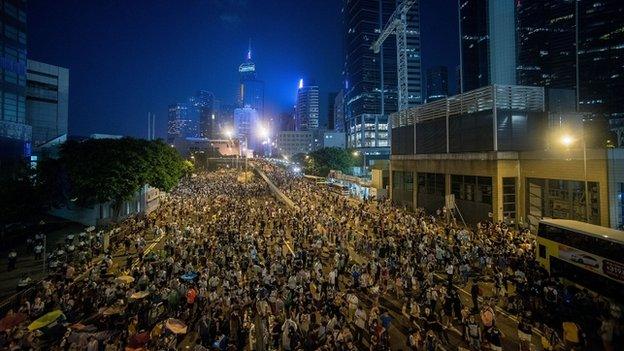
Many protesters remained in one of central Hong Kong's main avenues on Sunday evening
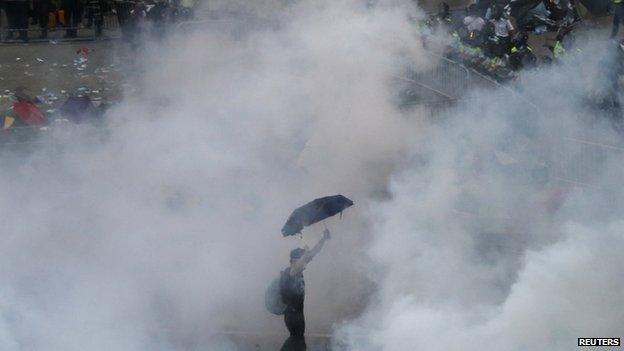
Crowds of protesters were earlier dispersed by volleys of tear gas but later returned
As evening fell, the police lobbed tear gas canisters into the crowd, scattering some of the protesters. But many of the demonstrators regrouped and retreated to a nearby park.
According to the AFP news agency, some 3,000 protesters blocked a second major thoroughfare in the Mongkok district of Kowloon late on Sunday.

At the scene: Juliana Liu, Hong Kong correspondent
After clashes with police earlier in the week, pro-democracy protesters appeared to be much better prepared on Sunday.
Many arrived sporting raincoats or wrapped in plastic with swimming goggles over their eyes - items chosen to protest against the sting of tear gas and pepper spray.
Still, there was surprise and chaos when the first round of tear gas was fired in the early evening. Thousands of people ran for cover when the canisters hit the ground, spewing white smoke and a distinctively sharp smell into the air.
I was helped by a middle-aged couple who noticed my growing baby bump and were concerned for my health. They pressed a water-soaked blue handkerchief into my face to reduce the amount of tear gas I would breath in. But they disappeared before I could thank them properly.
The BBC's Jiuliana Liu says the situation on the ground is "extremely chaotic" and that protesters show no sign of dispersing

The student organisers behind the protest, the Hong Kong Federation of Students, have appealed for students to retreat due to fears that police could use rubber bullets to disperse the crowd.
A co-organiser of Occupy Central, Chan Kin-man, says he supports the students' decision.
Police said they had arrested 78 people on Sunday on charges of "forcible entry into government premises, unlawful assembly, disorderly conduct in public place, assaulting public officers and obstructing police officers in due execution of duties".
It comes after the arrest of more than 70 people in Saturday's protests, including prominent student activist leader Joshua Wong, who has since been released.
Chief Executive CY Leung said the government was "resolute in opposing the unlawful occupation" by protesters
Thousands joined a sit-in organised by students outside government headquarters this weekend, bolstering a week-old protest, which began as a strike by students calling for democratic reforms.
Occupy Central had originally planned to paralyse the central business district next Wednesday, but organisers advanced the protest and changed the location in an apparent bid to harness momentum from student protests.
The announcement came early on Sunday, with a statement by the movement saying Mr Leung had "failed to deliver on political reform".
But speaking in his first public statement since the protests began, Mr Leung said that he and his government had "been listening attentively to members of [the] public".
He said that political consultations would continue on the planned changes but warned that "resolute" action would be taken against the "illegal demonstration".
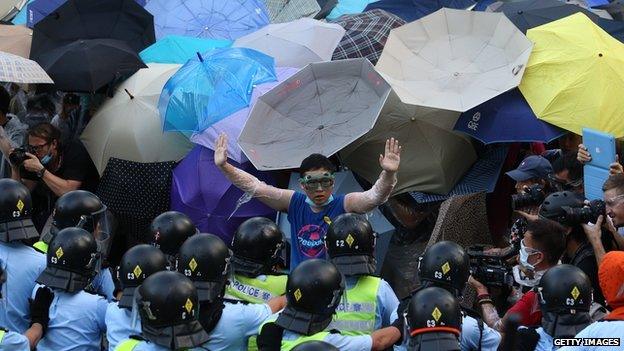
Umbrellas were used by activists to avoid the effects of tear gas and pepper spray
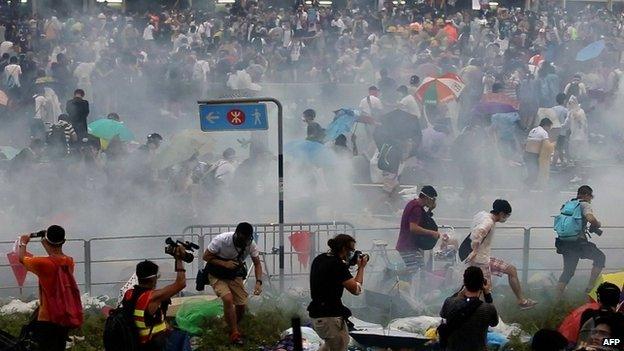
The main thoroughfare in central Hong Kong was blocked for several kilometres in each direction
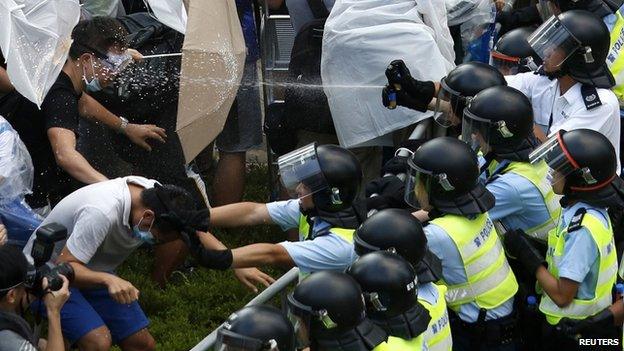
Students and activists have been camped outside the government premises all weekend
The protesters had also called for further talks but it is not clear how far - if at all - Mr Leung's mention of further consultations will be seen as recognising their demands.
A spokesman for China's Hong Kong and Macau affairs office said that Beijing "firmly opposes all illegal activities that could undermine rule of law and jeopardise 'social tranquillity' and it offers its strong backing" to the Hong Kong government, Xinhua news agency reports.

Police protected a cordon outside the government offices on Saturday night
Unrest began when the Chinese government announced that candidates for the 2017 chief executive election would first have to be approved by a nominating committee.
Activists have argued that this does not amount to true democracy.

Hong Kong democracy timeline
1984: Britain and China sign an agreement where Hong Kong is guaranteed "a high degree of autonomy, except in foreign and defence affairs" for 50 years following the handover in 1997.
2004: China rules that its approval must be sought for changes to Hong Kong's election laws.
2008: China says it will consider allowing direct elections by 2017.
June-July 2014: Pro-democracy activists hold an unofficial referendum on political reform and a large rally. This is followed by protests by pro-Beijing activists.
31 August 2014: China says it will allow direct elections in 2017, but voters will only be able to choose from a list of pre-approved candidates. Activists stage protests.
22 September 2014: Student groups launch a week-long boycott of classes in protest.